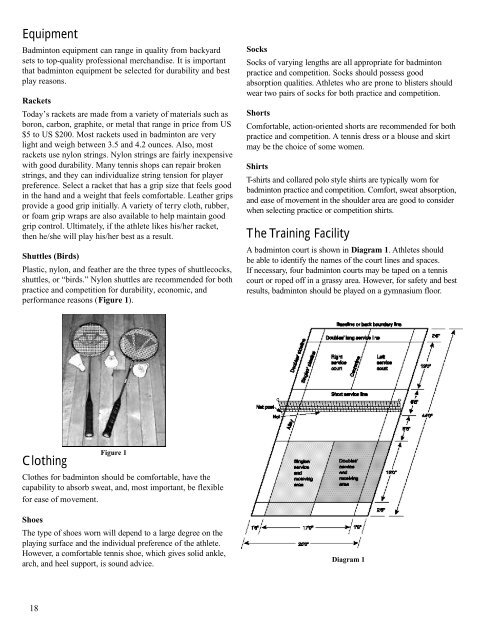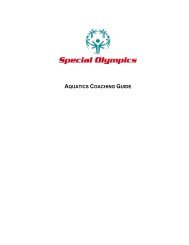BADMINTON Special Olympics Sports Skills Program
BADMINTON Special Olympics Sports Skills Program
BADMINTON Special Olympics Sports Skills Program
Create successful ePaper yourself
Turn your PDF publications into a flip-book with our unique Google optimized e-Paper software.
Equipment<br />
Badminton equipment can range in quality from backyard<br />
sets to top-quality professional merchandise. It is important<br />
that badminton equipment be selected for durability and best<br />
play reasons.<br />
Rackets<br />
Today’s rackets are made from a variety of materials such as<br />
boron, carbon, graphite, or metal that range in price from US<br />
$5 to US $200. Most rackets used in badminton are very<br />
light and weigh between 3.5 and 4.2 ounces. Also, most<br />
rackets use nylon strings. Nylon strings are fairly inexpensive<br />
with good durability. Many tennis shops can repair broken<br />
strings, and they can individualize string tension for player<br />
preference. Select a racket that has a grip size that feels good<br />
in the hand and a weight that feels comfortable. Leather grips<br />
provide a good grip initially. A variety of terry cloth, rubber,<br />
or foam grip wraps are also available to help maintain good<br />
grip control. Ultimately, if the athlete likes his/her racket,<br />
then he/she will play his/her best as a result.<br />
Shuttles (Birds)<br />
Plastic, nylon, and feather are the three types of shuttlecocks,<br />
shuttles, or “birds.” Nylon shuttles are recommended for both<br />
practice and competition for durability, economic, and<br />
performance reasons (Figure 1).<br />
Clothing<br />
Clothes for badminton should be comfortable, have the<br />
capability to absorb sweat, and, most important, be flexible<br />
for ease of movement.<br />
Shoes<br />
The type of shoes wo rn will depend to a large degree on the<br />
p l aying surface and the individual preference of the athlete.<br />
H oweve r, a comfort a ble tennis shoe, which gives solid ankle,<br />
arch, and heel support, is sound advice.<br />
1 8<br />
Figure 1<br />
Socks<br />
Socks of va rying lengths are all appropriate for badminton<br />
practice and competition. Socks should possess good<br />
a b s o rption qualities. Athletes who are prone to blisters should<br />
wear two pairs of socks for both practice and competition.<br />
Shorts<br />
C o m f o rt a ble, action-oriented shorts are recommended for both<br />
practice and competition. A tennis dress or a blouse and skirt<br />
m ay be the choice of some wo m e n .<br />
Shirts<br />
T- s h i rts and collared polo style shirts are typically wo rn for<br />
badminton practice and competition. Comfort, sweat absorp t i o n ,<br />
and ease of movement in the shoulder area are good to consider<br />
when selecting practice or competition shirt s .<br />
The Training Facility<br />
A badminton court is shown in D i a g ram 1. Athletes should<br />
be able to identify the names of the court lines and spaces.<br />
If necessary, four badminton courts may be taped on a tennis<br />
c o u rt or roped off in a grassy area. Howeve r, for safety and best<br />
results, badminton should be played on a gymnasium floor.<br />
Diagram 1

















